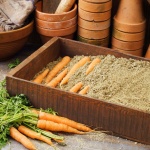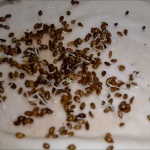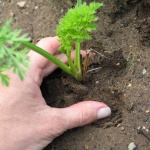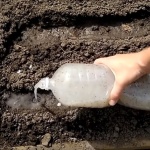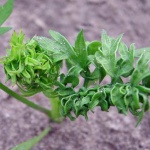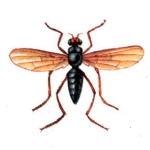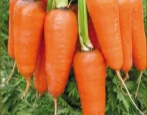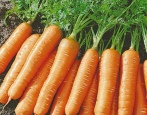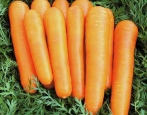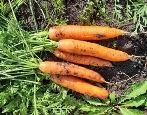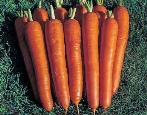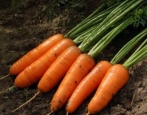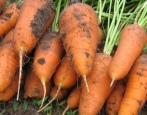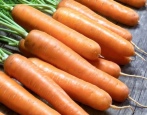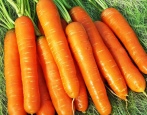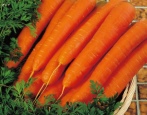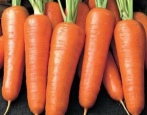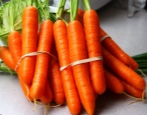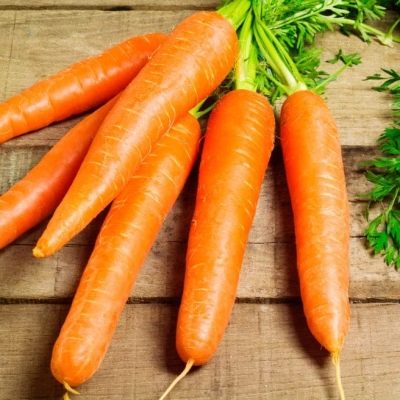
- Authors: Vinogradov Z.S., Kushch A.A., Zazimko V.V.
- Year of approval: 2005
- Appointment: for fresh consumption, for canning, for making juice
- Leaf rosette shape: sprawling
- Leaves: medium, green, finely cut
- Weight, g: 85-230
- The form : tapered, with a slightly pointed tip
- Taste qualities: good and excellent
- Composition : dry matter 10.2-16.2%, total sugar 6.1-10.9%, carotene 10.3-16.9 mg per 100 g of raw matter
- Ripening terms: late ripening
Carrot Queen of Autumn is considered one of the best varieties of this root crop. The plant has many positive characteristics, but it has very few disadvantages.
Breeding history
The breeders of Vinogradov, Kushch and Zazimko are considered the originators of the Queen of Autumn. Tests of the variety were carried out in domestic fields and ended in success. The variety has been listed in the State Register since 2005.
Description of the variety
The plant belongs to the Flakke cultivar. This results in a tapered shape and a rather large diameter. In addition, belonging to the variety indicates that carrots of this variety have less carotene than in the case of other subspecies. Let's list other features of culture:
- the possibility of long-term storage in a cold period;
- excellent productivity;
- interesting appearance, ensuring the marketability of the fruit;
- juicy pulp with a sweet taste;
- good germination of seed;
- smooth surface without cracks.
There are also negative sides:
- root vegetables are not as rich in shade as we would like;
- due to large-sized fruits, problems arise with extraction from the soil;
- If carrots are improperly stored, they will rot in most cases.
Characteristics of the appearance of the plant and root crops
The Queen of Autumn's carrot bushes have the following characteristics:
- long and spreading leaf rosette;
- medium-sized bright green foliage.
Now we will describe the root crops of the culture:
- length is 20-22 cm, sometimes up to 25 cm;
- the weight of carrots is 85-230 grams, most often there are specimens of 100-120 g;
- the tip of the fruit is pointed, cone-shaped;
- the bark and core differ in the same red tint;
- the surface of the root crops is smooth;
- harvested carrots lie well during the winter;
- carotene in fruits - 10.3-16.9 mg per 100 grams.
Purpose and taste of tubers
The queen of autumn is distinguished by the presence of juicy and tasty pulp. It is sweet, not bitter, and not watery. Root crops are always used in the kitchen. They can be boiled, used for grilling vegetables, eaten raw as salads, or just like that. Also, carrots are used for preservation, and also vitamin juice is obtained from it.
Maturation
The Queen of Autumn carrot is considered a late-ripening variety. It takes 120-130 days to fully mature.
Yield
The variety has a very good yield. Average figures are 265-576 centners per hectare. This discrepancy is due to the quality of the soil. On poor soils, not fertilized since autumn, the yield will be minimal. As for the indicators per square meter, it is 4.5-9 kg.
Growing regions
The Queen of Autumn is zoned into the following regions:
- Volgo-Vyatsky;
- TsCHO;
- Far Eastern.
In addition, the variety is widespread in Ukraine and Belarus, and is grown in a number of European countries.
Growing and care
Summer residents are engaged in sowing seeds in open ground in late April or early May, depending on the climate of the region. In some cases, the dates are shifted to early June. Planting in the soil is done in rows. The distance between them is 15 cm. And the step between the seeds is 5-7 cm. The seeds should be planted in moist soil to a depth of 2 centimeters. After planting, the crops are covered with foil until the sprouts are pecked.
The emerging seedlings require grooming measures from the gardener. As soon as the seeds hatch, weeding must be done. The next such procedure is carried out after 4 leaves appear on the sprouts. In this case, crop thinning is also carried out at the same time. Subsequent weeding should be carried out when necessary, but at least a couple of times a month.
The first month, carrot seedlings are watered often, about 3 times a week, and if it's hot, then every day. Then the frequency of watering is reduced to once every 7-10 days. If the summer is rainy, you need to focus on the condition of the soil. Filling the culture is prohibited.
You will have to feed the plants only twice: immediately after thinning and another 21 days later. For the first time, they give such substances:
- phosphorus - 40 grams;
- potassium - 60 grams;
- nitrogen - 50 grams.
The second feeding is the same, but the dosage should be half as much (20, 30, 25 g, respectively).
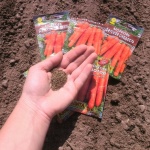
Carrots are one of the most unpretentious crops in terms of growing conditions; they can endure a short drought and a short cold snap. However, to get tasty and large root crops, you should adhere to the basic rules for planting carrots.
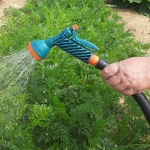

Soil requirements
If you want to get the maximum yield, then the quality of the soil will have to be taken care of first of all. In general, the Queen of Autumn prefers sandy or light loamy soils. Preparing them for planting, the soil is fertilized with rotted organic matter. Fresh carrot manure is contraindicated as it increases the nitrogen concentration in the soil. The ground should be neutral or slightly acidic.
Required climatic conditions
Sowing seeds should be done in a place that is well lit. In shade or partial shade, carrots will also grow, but they will not turn out to be as tasty as expected. Plants tolerate drought well, heat in general, too. They perfectly resist the cold, they are able to survive a short-term decrease to -4.
Disease and pest resistance
The Queen of Autumn is best at resisting blooming and cracking. However, in humid summers it can be easily affected by bacteriosis. This is a fungal disease that provokes the appearance of brown spots on the fruit. It can also be carried by insects. Another disease that is often found in this variety is phomosis. It manifests itself during storage, is the cause of mummification and drying of the fruit. But, in fact, there will be only one pest - a carrot fly.
Here are some steps you can take to avoid infections and malicious attacks:
- following the rules of crop rotation;
- cultivation on dry soils;
- moderate watering;
- collection of the product in dry weather;
- preventive spraying from insects.
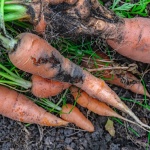
Carrots grow in almost any garden. There is an opinion that this culture is very resistant to all kinds of diseases and pests, but this is not the case.Without proper care, carrots become susceptible to all kinds of infections and are affected by harmful insects.
Review overview
Vegetable growers love the Queen of Autumn carrot variety. This is the very thing if you need a late subspecies for feeding in winter. Summer residents say that carrots are sweet and juicy, albeit not very colorful. She rises amicably, sings on time, does not require special care and constant attention. It gets sick relatively rarely, and yields excellent yields.
True, pulling it out of the ground is not very easy, but summer residents do not consider this a completely serious drawback. But they argue that it is this form of carrots that provides convenience when cooking, especially when making juice.

